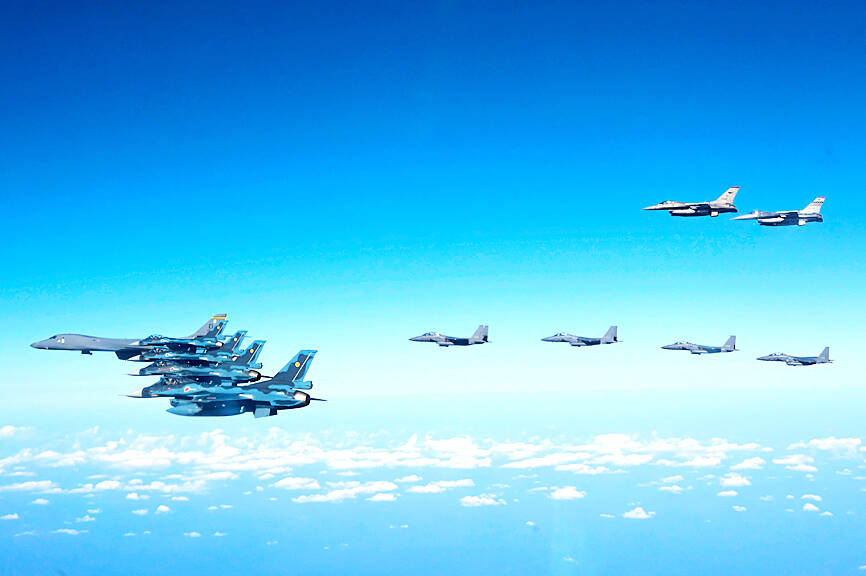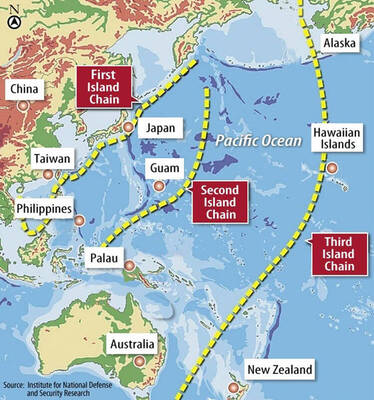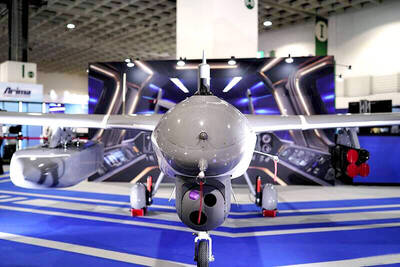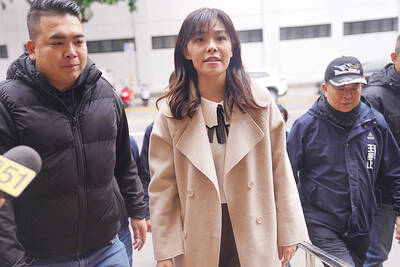The US yesterday flew a long-range bomber in a trilateral drill with South Korea and Japan in response to North Korea’s recent test-firing of a new intercontinental ballistic missile designed to strike the US mainland, South Korea’s military said.
North Korea on Thursday tested the newly developed Hwasong-19 ICBM, which flew higher and stayed in the air longer than any other missile it has fired. North Korean leader Kim Jong-un called it “an appropriate military action” to cope with external security threats posed by its rivals.
The US yesterday flew a B-1B bomber to train with South Korean F-15Ks and KF-16s, and Japanese F-2s near the Korean Peninsula, demonstrating the three countries’ firm resolve and readiness to respond to North Korea’s advancing nuclear and missile programs, South Korea’s Joint Chiefs of Staff said in a statement.

Photo: US Air Force / AFP
“The exercise demonstrates the commitment of the ROK [Republic of Korea]-US alliance to integrate extended deterrence in response to the advancing nuclear and missile threats from North Korea,” the statement said.
During the aerial maneuver, South Korean and Japanese jets escorted the US strategic bomber to a designated location south of the Korean Peninsula, “demonstrating an overwhelming capability to swiftly and accurately strike simulated targets,” it added.
The B-1B Lancer is a supersonic heavy bomber known for its high-speed performance with a payload of 34,000kg of munitions, including conventional and precision-guided weapons.
It was the fourth time this year the bomber was deployed to the Korean Peninsula and the second time for a trilateral aerial exercise to counter Pyongyang’s military threats, the military said.
The official Korean Central News Agency hailed Thursday’s ICBM launch as “the world’s strongest strategic missile.”
The test-firing showed progress in North Korea’s missile program, but many experts say it still has some technological issues to master to acquire functioning ICBMs that can deliver nuclear strikes on the US mainland.
Kim “expressed great satisfaction” at the successful launch, the agency reported.
North Korea “would never change its line of bolstering up its nuclear forces,” it said.
The Hwasong-19 shown in North Korea’s state media photographs and videos appeared too big to be useful in a war, experts said.
The launch came amid growing international scrutiny over Pyongyang’s purported deployment of thousands of troops to Russia to support Moscow’s war efforts in Ukraine, raising concerns North Korean soldiers in Russian uniforms could soon engage in combat.

The US government has signed defense cooperation agreements with Japan and the Philippines to boost the deterrence capabilities of countries in the first island chain, a report by the National Security Bureau (NSB) showed. The main countries on the first island chain include the two nations and Taiwan. The bureau is to present the report at a meeting of the legislature’s Foreign Affairs and National Defense Committee tomorrow. The US military has deployed Typhon missile systems to Japan’s Yamaguchi Prefecture and Zambales province in the Philippines during their joint military exercises. It has also installed NMESIS anti-ship systems in Japan’s Okinawa

‘WIN-WIN’: The Philippines, and central and eastern European countries are important potential drone cooperation partners, Minister of Foreign Affairs Lin Chia-lung said Minister of Foreign Affairs Lin Chia-lung (林佳龍) in an interview published yesterday confirmed that there are joint ventures between Taiwan and Poland in the drone industry. Lin made the remark in an exclusive interview with the Chinese-language Liberty Times (the Taipei Times’ sister paper). The government-backed Taiwan Excellence Drone International Business Opportunities Alliance and the Polish Chamber of Unmanned Systems on Wednesday last week signed a memorandum of understanding in Poland to develop a “non-China” supply chain for drones and work together on key technologies. Asked if Taiwan prioritized Poland among central and eastern European countries in drone collaboration, Lin

BACK TO WORK? Prosecutors said they are considering filing an appeal, while the Hsinchu City Government said it has applied for Ann Kao’s reinstatement as mayor The High Court yesterday found suspended Hsinchu mayor Ann Kao (高虹安) not guilty of embezzling assistant fees, reducing her sentence to six months in prison commutable to a fine from seven years and four months. The verdict acquitted Kao of the corruption charge, but found her guilty of causing a public official to commit document forgery. The High Prosecutors’ Office said it is reviewing the ruling and considering whether to file an appeal. The Taipei District Court in July last year sentenced Kao to seven years and four months in prison, along with a four-year deprivation of civil rights, for contravening the Anti-Corruption

NO CONFIDENCE MOTION? The premier said that being toppled by the legislature for defending the Constitution would be a democratic badge of honor for him Premier Cho Jung-tai (卓榮泰) yesterday announced that the Cabinet would not countersign the amendments to the local revenue-sharing law passed by the Legislative Yuan last month. Cho said the decision not to countersign the amendments to the Act Governing the Allocation of Government Revenues and Expenditures (財政收支劃分法) was made in accordance with the Constitution. “The decision aims to safeguard our Constitution,” he said. The Constitution stipulates the president shall, in accordance with law, promulgate laws and issue mandates with the countersignature of the head of the Executive Yuan, or with the countersignatures of both the head of the Executive Yuan and ministers or